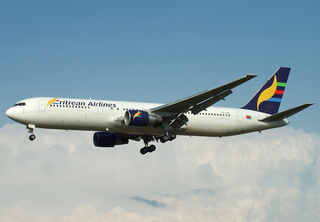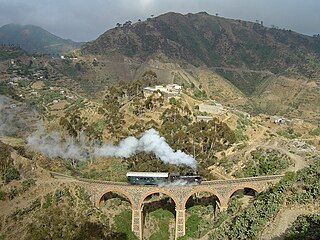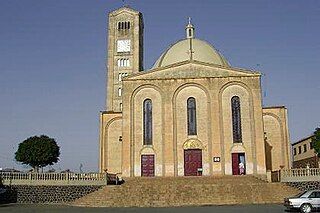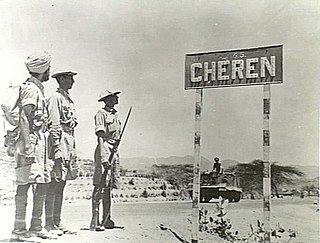
The economy of Eritrea has experienced considerable growth in recent years, indicated by an improvement in gross domestic product (GDP) in October 2012 of 7.5 percent over 2011. However, worker remittances from abroad are estimated to account for 32 percent of gross domestic product. Eritrea has an extensive amount of resources such as copper, gold, granite, marble, and potash. The Eritrean economy has undergone extreme changes due to the War of Independence.

Transport in Eritrea includes highways, airports and seaports, in addition to various forms of public and private vehicular, maritime and aerial transportation.

Asmara, or Asmera, is the capital and most populous city of Eritrea, in the country's Central Region. It sits at an elevation of 2,325 metres (7,628 ft), making it the sixth highest capital in the world by altitude. The city is located at the tip of an escarpment that is both the northwestern edge of the Eritrean Highlands and the Great Rift Valley in neighbouring Ethiopia. In 2017, the city was declared as a UNESCO World Heritage Site for its well-preserved modernist architecture. The site of Asmera was first settled in 800 BC with a population ranging from 100 to 1,000. The city was then founded in the 12th century AD after four separate villages unified to live together peacefully after long periods of conflict. Under Italian rule the city of Asmara was made capital of Eritrea in the last years of the 19th century.

The Eritrean Railway is the only railway system in Eritrea. It was constructed between 1887 and 1932 during the Italian Eritrea colony and connects the port of Massawa with Asmara. Originally it also connected to Bishia. The line was partly damaged by warfare in subsequent decades, but was rebuilt in the 1990s. Vintage equipment is still used on the line.

Massawa is a port city in the Northern Red Sea region of Eritrea, located on the Red Sea at the northern end of the Gulf of Zula beside the Dahlak Archipelago. It has represented a historically important port for many centuries.

The Asmara-Massawa Cableway was a cableway built in Italian Eritrea before World War II.The Eritrean Ropeway, completed in 1937, ran 71.8 km from the south end of Asmara to the city-port of Massawa.

The Eritrean People's Liberation Front (EPLF), informally known as Shabia, was an armed Marxist–Leninist organization that fought for the independence of Eritrea from Ethiopia. It emerged in 1970 as a far-left to left-wing nationalist group that split from the Eritrean Liberation Front (ELF). After achieving Eritrean independence in 1991, it transformed into the People's Front for Democracy and Justice (PFDJ), which serves as Eritrea's sole legal political party.

Teseney, also spelled Tessenei or Tesseney, is a market town in western Eritrea. It lies south-east of Kassala in Sudan, on the Gash River. The city was much fought over in the Eritrean War of Independence during which much of it was destroyed. After the war, Tessenei has become a governmental administrative center with customs and agricultural offices and a military base.

The Eritrean Catholic Church is a metropolitan sui iuris Eastern particular church headquartered in Asmara, Eritrea. It was established in 2015 by separation of its territory from that of the Ethiopian Catholic Church and the setting up in that territory of a new sui iuris metropolitan Eastern Catholic Church. It follows the Ge'ez form of the Alexandrian liturgical rite. Its strictly-speaking official name is "The Asmara metropolitan sui iuris Church".
Modern banking in Eritrea started with the arrival of the Italian colonizers. However, from 1974 on, the banking sector became a government monopoly. This situation continued after Eritrea achieved its independence. The Bank of Eritrea is the central bank of Eritrea.

The Eritrean Telecommunication Services Corporation, more commonly known as EriTel, is the sole operator of landline telephone communication infrastructure in Eritrea. It is also the sole operator of the mobile telephone service. However, it is but one of several internet service providers in the country.

The Battle of Keren took place from 3 February to 27 March 1941. Keren was attacked by the British during the East African Campaign of the Second World War. A force of Italian regular and colonial troops defended the position against British troops and Free French forces. The town of Keren, in the colony of Italian East Africa, was of tactical importance to both sides. The road and railway through Keren were the main routes to the colonial capital of Italian Eritrea at Asmara and the Red Sea port of Massawa, which surrendered to the British after the battle.

Kagnew Station was a United States Army installation in Asmara, Eritrea on the Horn of Africa. The installation was established in 1943 as a U.S. Army radio station, taking over and refurbishing a pre-existing Italian naval radio station, Radio Marina, after Italian forces based in Asmara surrendered to the Allies in 1941. Kagnew Station operated until April 29, 1977, when the last Americans left. The station was home to the United States Army's 4th Detachment of the Second Signal Service Battalion.

Eritrea, officially the State of Eritrea, is a country in the Horn of Africa region of Eastern Africa, with its capital at Asmara. It is bordered by Ethiopia in the south, Sudan in the west, and Djibouti in the southeast. The northeastern and eastern parts of Eritrea have an extensive coastline along the Red Sea. The nation has a total area of approximately 117,600 km2 (45,406 sq mi), and includes the Dahlak Archipelago and several of the Hanish Islands.

Italian Eritreans are Eritrean-born descendants of Italian settlers as well as Italian long-term residents in Eritrea.
The Eritrean–Ethiopian War ended with the signing of the Algiers Agreement on December 12, 2000. In 2002, in an effort to mitigate the effects of the prolonged stalemate with Ethiopia, the President's Administration created the Wefri Warsay Yika'alo. It is a comprehensive, revolutionary, national economic rehabilitation and development program in the aftermath of the destructive war with Ethiopia. Due to his frustration with the stalemated peace process with Ethiopia, the President of Eritrea Isaias Afewerki wrote a series of Eleven Letters to the UN Security Council and Secretary-General Kofi Annan. Despite the Algiers Agreement, tense relations with Ethiopia have continued and led to regional instability.

Italian Eritrea was a colony of the Kingdom of Italy in the territory of present-day Eritrea. The first Italian establishment in the area was the purchase of Assab by the Rubattino Shipping Company in 1869, which came under government control in 1882. Occupation of Massawa in 1885 and the subsequent expansion of territory would gradually engulf the region and in 1889 borders with the Ethiopian Empire were defined in the Treaty of Wuchale. In 1890 the Colony of Eritrea was officially founded.
Sichuan Road and Bridge Group is a Chinese engineering company that builds civil works in domestic and international projects.

Eritrea–India relations refers to the international relations that exist between Eritrea and India. Eritrea maintains an embassy in New Delhi. India maintains an embassy in Asmara since 2021. Erstwhile, India was represented to Eritrea through its High Commission in Khartoum, Sudan.
The following is a timeline of the history of the city of Asmara, Eritrea. Asmara was under Italian colonial rule from 1889 until 1941.















